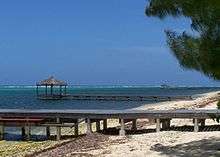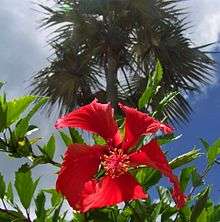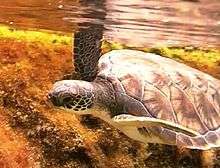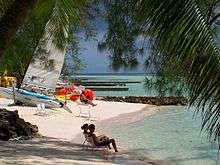Grand Cayman
 Grand Cayman from space, April 1994 | |
 Grand Cayman | |
| Geography | |
|---|---|
| Location | Caribbean |
| Coordinates | 19°20′N 81°13′W / 19.333°N 81.217°W |
| Archipelago | Greater Antilles |
| Area | 196 km2 (76 sq mi) |
| Highest elevation | 18 m (59 ft) |
| Highest point | unnamed |
| Administration | |
| Territory |
|
| Largest settlement | George Town (pop. 27,704) |
| Demographics | |
| Population | 52,601 (2010) |
| Pop. density | 224.6 /km2 (581.7 /sq mi) |
| Ethnic groups | mixed 40%, white 20%, black 20%, expatriates of various ethnic groups 20% |
Coordinates: 19°20′N 81°13′W / 19.333°N 81.217°W
Grand Cayman is the largest of the three Cayman Islands and the location of the territory's capital, George Town. In relation to the other two Cayman Islands, it is approximately 75 miles (121 km) southwest of Little Cayman and 90 miles (145 km) southwest of Cayman Brac.
Geography
Grand Cayman encompasses 76% of the territory's entire land mass. The island is approximately 22 miles (35 km) long with its widest point being 8 miles (13 km) wide.[1] The elevation ranges from sea level at the beaches to 60 feet (18 m) above sea level on the North Side's Mastic Trail.[2][3]
Island districts

Grand Cayman Island includes five of the six districts of the Cayman Islands: Bodden Town, East End, George Town, North Side, and West Bay.[4]
- Bodden Town - Founded in the 1700s, Bodden Town district comprises the central part of Grand Cayman Island, between the George Town and North Side districts. The village of Bodden Town was the original capital of the Cayman Islands. Its population is currently listed at 5,764.
- East End - The East End district is located at the east side of Grand Cayman Island and consists mostly of the Village of East End, numerous natural attractions, restaurants, and accommodations. Its population is currently listed at 1,371.
- George Town - The capital of the Cayman Islands and world-famous centre for offshore banking and investments, its population is currently listed at 20,676.
- North Side - Includes Kaibo, Rum Point, and Breakers. Its population is currently listed at 1,079. Sand Point Cove in Rum Point is home to a Bioluminescent Bay or Bio Bay.
- West Bay - Has numerous tourist attractions including the Cayman Turtle Farm and the Cayman Motor Museum. Towns in the West Bay district include Seven Mile Beach, Hell, and West Bay Village. Its population is currently listed at 8,243.
The remaining district is Sister Islands, which consists of the islands of Cayman Brac and Little Cayman. Its population is currently listed at 1,937.
Flora and fauna
Flora

Of the flora, a good representation of the variety of plant life on Grand Cayman can be found at the Queen Elizabeth II Botanic Park located in the North Side District. Wild banana orchids, ghost orchids, thatch palm trees, red birch trees, mahogany trees and various fruit trees such as plantain, mango, breadfruit, and tamarind. Yellow mastics (Sideroxylon foetidissimum), black mastics (Terminalia eriostachya) are also seen in the park as well as on the 2 miles (3.2 km)-long Mastic Trail. Elsewhere outside the park, all of these species can be seen around Grand Cayman, including coconut palm, Casuarina pine, mangrove, and poinciana trees.
Fauna


Fauna seen in various locations around the island include blue iguanas (Cyclura lewisi), Grand Cayman amazon parrots (Amazona leucocephala caymanensis), Central American agouti (Dasyprocta punctata), and Gecarcinus ruricola, a species of land crab. The Cayman Islands Turtle Farm located in the West Bay district raises green sea turtles for their meat and to release into the wild.
Through breeding, the farm produces upwards of 1800 turtles a year. Between 1980 and 2006, the farm released approximately 30,600 turtles to the wild; because of a mark placed on each animal, the released turtles have been seen throughout the Caribbean.[5]
There are 4 endemic snake species on Grand Cayman and 2 invasive species. They are all non-venomous and the largest is the rarely seen invasive corn snake, which may grow to about 5 feet. The smallest grows to about 6 inches and is the invasive brahminy blind snake which is also rarely seen. The most common is the endemic Cayman racer snake.[6] It can grow to approximately 6 feet, but 3-foot specimens are much more common. These snakes tend to race away if encountered and in rare cases will rear-up in a threatening manner if cornered. The other 3 endemic snake species are the Cayman ground boa, Cayman blind snake and Cayman water snake.
Demographics
Of the three islands, Grand Cayman contains approximately 95% of the territory's entire population.[7]
Economy
Offshore banking
There are just under 600 banks and trust companies in the Grand Cayman, including 43 of the 50 largest banks in the world.[8] Because of this large financial presence on the island, banking, investments, and insurance drive the economy in Grand Cayman.[9]
Tourism

There are fast food restaurants, night clubs, and resorts on the western side of the island down to George Town. The eastern districts have more restaurants specialising in native Caymanian cuisine.
Because of its clubs, resorts, and hotels, Seven Mile Beach has the largest concentration of visitors and tourists on the island.
Watersports such as scuba diving and snorkeling are among the most popular activities on Grand Cayman as the island is known for its coral reefs and underwater sea walls along with a number of shipwrecks.
As well, Grand Cayman Island also has a number of natural attractions: the blow holes in the East End district, the Mastic Trail that runs north to south through the center of the island, Hell in the West Bay, and the acclaimed Queen Elizabeth II Botanic Park, to name a few.
Infrastructure
Owen Roberts International Airport serves Grand Cayman with domestic and international flights. Cayman Airways has its headquarters on Grand Cayman.[10]
Electrical service for Grand Cayman is provided by Caribbean Utilities Company Ltd., with its corporate headquarters located on North Sound Road. Electricity on Grand Cayman runs on a 120/240 volt electricity system with electrical outlets designed to accommodate a three-pin American plug.
Grand Cayman residents have a choice of telecommunications services from C3, Digicel, LIME,Flow and Logic.
Education
The Cayman Islands Education Department operates government schools.
Secondary schools operated by Government
Primary schools operated by Government
- Bodden Town Primary School
- John A. Cumber Primary School
- East End Primary School
- George Town Primary School
- North Side Primary School
- Prospect Primary School
- Red Bay Primary School
- Savannah Primary School
Private schools

- Cayman Academy
- Cayman International School[12]
- Cayman Prep and High School[13]
- First Baptist Christian School (ages 3 months-11 years, grades preschool through 6)[14]
- Grace Christian Academy
- Montessori School of Grand Cayman[15]
- St. Ignatius Catholic School[16]
- Triple C School[17]
- Truth For Youth School
- Wesleyan Christian Academy
- Hope Academy
Private universities
- St. Matthews University of Medicine/Veterinary Medicine
- International College of the Cayman Islands (ICCI)
- The Cayman Islands Law School[18]
Public Universities
See also
References
- ↑ "Cayman Islands Official Tourism Website - Welcome to the Cayman Islands". caymanislands.ky.
- ↑ "Warning!". gov.ky.
- ↑ "Cayman Wildlife Connection". caymanwildlife.org.
- ↑ "Cayman Islands Districts". statoids.com.
- ↑ "Cayman Islands Turtle Farm" (PDF). Retrieved 2011-07-09.
- ↑ "Wildlife/Fauna - Cayman Travel Guide".
- ↑ "The Cayman Islands 2010 Population and Housing Census: Preliminary Report" (PDF). Economics and Statistics Office. 7 February 2011. Retrieved 2 June 2011.
- ↑ cayman-information.com Cayman Islands Banking
- ↑ Oxford Economics Study: 55% of the Economy in Grand Cayman is Banking
- ↑ "Contact Us". Cayman Airways. Retrieved 19 October 2009.
- ↑ "Learning Village - John Gray High School". Retrieved 2008-06-23.
- ↑ "Cayman International School". caymaninternationalschool.org.
- ↑ "Home". cayprep.edu.ky.
- ↑ "First Baptist Christian School and Wee Care - Christ Centered Education in the Cayman Islands". FBCS & WEE Care.
- ↑ "montessori-school". montessori-school.
- ↑ "Our Mission". st-ignatius.com.
- ↑ "Triple C School - Welcome to Triple C School". triplecschool.org.
- ↑ http://www.lawschool.gov.ky
External links
| Wikimedia Commons has media related to Grand Cayman Island. |
- Cayman Islands Department of Tourism
- Cayman Travel Guide
- Cayman Islands Government
- "CIA - The World Factbook - Cayman Islands". Retrieved 2008-06-23.
-
 Grand Cayman travel guide from Wikivoyage
Grand Cayman travel guide from Wikivoyage - "National Hurricane Committee - Emergency Management". Cayman Islands Government. Retrieved 2007-08-18.
